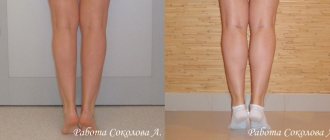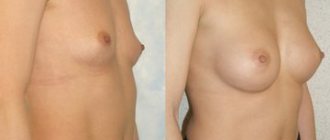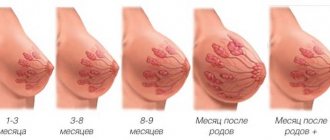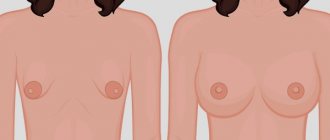Operation
Breast reduction surgery is performed under general anesthesia and is a serious surgical procedure that requires special attention.
During the preparatory stage, a plan for the operation is outlined, the locations of future incisions are determined, in order to make them invisible after healing.
Usually the operation is performed through two types of access:
- vertical (for minor correction volumes) The incision is located along the edge of the areola and goes down to the inframammary fold.
- "anchor" The incision is located along the edge of the areola, going down to the inframammary fold, where another incision is located. This type of access is used when it is necessary to remove a large volume of tissue (for example, with gigantomastia).
After removing excess tissue, cosmetic sutures are applied (a drainage tube is inserted into the chest), and a tight bandage is applied to protect and support the breast during the postoperative period.
Breast reduction surgery may involve both purely removal of excess tissue and a lift.
Preparing for breast reduction surgery
For plastic surgery for breast reduction you need:
- Review your medical record and assess your general health
- Discuss your expectations regarding breast size and appearance after surgery
- Provide you with a detailed description of the procedure, risks and guarantees, including possible scarring and loss of sensation
- Examine and measure your breasts
- Take pictures of your breasts for your medical record
- Explain the type of anesthesia used during surgery
Before breast reduction surgery you will also need:
- Pass various laboratory tests
- Obtain a baseline mammogram
- Do not smoke for a certain period of time before and after surgery
- Do not use aspirin, anti-inflammatory drugs or dietary supplements to stop bleeding during surgery.
After the operation, you need to stay in the clinic for a day.
Postoperative period
The first days after reduction mammoplasty, it is necessary to change the dressings at the intervention site daily. As a rule, it is recommended to remain in bed for several days, but this recommendation depends on the degree of complexity of the intervention and the general condition of the patient. Specialists prepare an individual list of recommendations on physical limitations for each patient.
The bandage and drainage are removed after two days, after which it is mandatory to wear compression garments for at least 2.5-3 weeks. A bra with compression properties gives the renewed breast the desired shape and helps damaged tissue heal.
You can return to work (if it does not involve physical labor) a week after the operation.
Serious physical activity is excluded for at least 2 weeks (this also applies to raising your arms above chest level), and sometimes longer. Sports training and contact sports are excluded for at least six months.
Different types of tissue (and breasts are made up of glandular, muscle and fatty tissue) heal at different rates, which is why the breasts may appear asymmetrical for the first one and a half to two weeks. As recovery progresses, this asymmetry disappears.
Breast reduction
Large breasts bother no fewer women than their insufficient size. In addition to purely aesthetic inconvenience and psychological problems, large breast size causes pain in the neck, shoulders and back, the inability to play sports, difficulties in choosing clothes, sweating and diaper rash in hot weather. In addition, large breasts are often combined with sagging (after breastfeeding) and some asymmetry. Therefore, women often resort to plastic surgery for breast reduction, which is called reduction or breast reduction surgery.
Purpose of the operation: The purpose of this operation is to reduce the volume and size of the mammary glands in combination with a one-stage lift (mastopexy), relocation of the nipples and giving the breasts a new, more beautiful shape.
Indications for surgery: • hypermastia - excessively large breasts that cause discomfort to a woman; • woman's dissatisfaction with the appearance of her mammary glands.
Contraindications: • any decompensated diseases of internal organs, colds, infectious and inflammatory diseases, as well as menstruation at the time of surgery; • significant bleeding disorders in the patient; • insulin-dependent diabetes mellitus.
Anesthesia: The operation is performed only under general anesthesia.
Features of the operation: As a result of the operation, excess skin, fatty tissue and breast tissue are excised. The nipple-areolar complex, as a rule, moves to a new location with a higher level of location. A similar operation is performed on the opposite side. Most often, drainage tubes are left in wounds for 1-2 days. At the end of the operation, a cosmetic suture is applied to the skin. The duration of operations depends on the experience of the surgeon and the massiveness of the mammary glands.
Postoperative period:
After the operation, observation in the hospital is required for 1-2 days. Tissue swelling is usually significant and usually decreases over the first 3-5 weeks. There may be hematomas and bruises. Limiting activity and wearing special compression garments is advisable for up to 3 weeks to one month after surgery. The sutures are removed approximately 18-21 days. By the end of the first month, you can engage in light exercise and return to sports.
Possible complications and side effects:
After approximately 5 months, the final results of the operation are assessed. Often at first the shape of the mammary glands is deformed, the nipples are higher than the desired level. Over time, the shape of the breast acquires its final aesthetic appearance. In our clinic in Minsk, breast reduction services are performed by the most experienced plastic surgeons with extensive experience in performing such operations. The results of our work can be found on the Internet, as well as during a consultation with a doctor. Check prices by phone.
Result
You can evaluate the result after one and a half to two months, but you will be able to fully enjoy your new breasts after 4-5 months.
For the operation it is necessary to undergo a number of tests:
- Complete blood count + platelets + coagulation (valid for 10 days)
- Blood type, Rh factor
- Coagulogram (valid for 10 days)
- General urine test (valid for 10 days)
- RW blood test (valid for 1 month)
- HIV test (valid for 1 month)
- Fluorography (valid for 12 months)
- Blood test for hepatitis B, C (valid for 1 month)
- Biochemical blood test (total protein, sodium, potassium, calcium, chlorine, cholesterol, urea, creatinine, glucose, total bilirubin, direct bilirubin, AST, ALT, chlorides) (valid for 10 days)
- ECG with interpretation (cardiologist's report if necessary) (valid for 1 month)
- Conclusions of specialized specialists (endocrinologist, cardiologist, therapist, etc. according to indications) (valid for 14 days)
- Physician's conclusion for persons over 50 years of age (valid for 14 days)
- Ultrasound of the mammary glands (valid for 1 month)
- In the presence of chronic diseases - an extract from the outpatient card with a physician’s conclusion (valid for 14 days)
Read reviews from our patients >>
Breast reduction
Reduction mammoplasty involves removing excess skin and fat, and in some cases, partially glandular tissue. The goal of plastic surgery is to create breasts of such a size that they proportionally match the patient’s build. There is a gradation by weight: up to 500g - small and moderate size breasts, up to 1000g - large size, and very large - more than 1500g. During the operation, 300-600 g of tissue is removed, but for a significant effect that will relieve pain in the spine, at least 500 g must be removed from each mammary gland.
Indications for breast reduction
Surgical intervention is performed on patients with gigantomastia (very large breasts), which causes them aesthetic and physical discomfort. Problems are associated with the selection of clothes and underwear, excessive sweating under the glands and the occurrence of irritation there, back pain, especially in the cervical spine, changes in posture, increased fatigue, abrasion of the skin in places of pressure from the bra straps. Such women are limited in playing sports, and they develop ptosis (drooping) of the mammary glands more quickly.
Contraindications
- ARVI, acute respiratory infections;
- exacerbation of chronic diseases of the respiratory system and cardiovascular system;
- severe general somatic conditions (severe cardiac, respiratory, hepatic, renal failure);
- blood clotting disorder.
In any case, the issue of surgical intervention is decided individually by your surgeon. If necessary, additional examination and consultations with specialist doctors are prescribed.
Progress of the operation
Before breast reduction, the doctor takes photographs of the patient’s mammary glands, measures some parameters and makes markings. The operation is performed under general anesthesia. In accordance with the markings, the surgeon makes access.
For breast reduction, two types of incisions are most often used: vertical and anchor. The first option is preferable for a small amount of surgery: the incision goes around the areola and goes vertically down to the inframammary fold. The anchor approach is carried out in the same way, but is supplemented by a horizontal incision under the breast. This technique is recommended for use when performing reduction mammoplasty and breast lift together in order to achieve maximum aesthetic results.
After dissection, excess fatty and glandular tissue is removed and excess skin is excised. The nipple and areola, without being separated from the blood vessels and nerves, are moved to a higher position. If necessary, the areola can be reduced so that it proportionally matches the new breast size. Next, a drainage tube is installed in each mammary gland to remove accumulated fluid, the edges of the wound are sutured and a sterile bandage is applied.
In situations where a woman has gigantomastia with a high degree of ptosis of the mammary glands and significant surgical intervention is required, relocation of the nipple with the areola becomes possible only after complete separation. Thus, after such an operation, sensitivity and the possibility of lactation are often lost.
Postoperative rehabilitation
The duration of the recovery period after breast reduction surgery is 1-2 months. Drains and dressings are removed after 2 days. External sutures are removed after 2 weeks. After a week you can return to work. Bruising and swelling disappear within a few weeks. The scars remain bright for up to six months, then fade. It is recommended to wear compression garments for 1 month, sleep on your back for the first time, and avoid intense physical activity for 6 months.
TESTS required for the operation:
- Complete blood count + platelets + coagulation (valid for 10 days)
- Blood type, Rh factor
- Coagulogram (valid for 10 days)
- General urine test (valid for 10 days)
- RW blood test (valid for 1 month)
- Fluorography (valid for 12 months)
- Blood test for hepatitis B, C (valid for 1 month)
- Biochemical blood test (total protein, sodium, potassium, calcium, chlorine, cholesterol, urea, creatinine, glucose, total bilirubin, direct bilirubin, AST, ALT, chlorides) (valid for 10 days)
- ECG with interpretation (cardiologist's report if necessary) (valid for 1 month)
- Conclusions of specialized specialists (endocrinologist, cardiologist, therapist, etc. according to indications) (valid for 14 days)
- Physician's conclusion for persons over 50 years of age (valid for 14 days)
- Ultrasound of the mammary glands + examination by an oncomammologist (valid for 1 month)
- In the presence of chronic diseases - an extract from the outpatient card with a physician’s conclusion (valid for 14 days)
The estimated price of breast reduction is from 3000.00 BYN. up to 5500.00 BYR Your doctor will tell you the exact cost during your consultation, after assessing the scope of the operation.
The cost of a consultation with a plastic surgeon is 20.00 BYR.
CONTRAINDICATIONS
- Malignant neoplasms in the stage of incomplete treatment
- Diabetes
- Immunodeficiency conditions
- Chronic diseases in the acute stage
PRICES FOR BREAST ENLARGEMENT
The cost of implants is 1100 euros.
| NAME | Price, white rubles |
| Breast augmentation (without the cost of implants and lingerie) | 5000 |
| Repeated mammoplasty (m/f re-prosthetics) (without the cost of implants and underwear) | 7000 |
Vladimir Aleksandrovich Kosinets conducts consultations in Minsk and Vitebsk. You can make an appointment by phone +375 25 902 19 44.
PROGRESS OF THE OPERATION
The surgeon's optimal access to tissue is achieved using a combination of periareolar and anchor incisions. The next stage is excision of the internal breast tissue. As a rule, the areola and nipple do not change their location, but in advanced cases they can be transplanted to a new location. Finally, excess skin is removed and cosmetic stitches are applied. Drainage remains in the wound for some time to drain excess blood. After the operation, an aseptic bandage is applied to the chest and secured with a special bodice.











